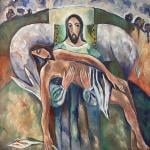 Cognitive restructuring becomes a monumental task when attempting to provide psychotherapy to certain populations of people. One such population being that of the conservative, Pentecostal, African-American community. Due to my heritage within that community as well as some of the relational connections which yet remain between that community and me, I am often asked to provide mental health treatment to those who are a part of that community. Though I am always joyful to be able to serve those from within my same community, I also find the task often daunting. Some of the very same deep religious cognitive structures that have often caused people within the African-American pentecostal community to feel shamed, mocked, inadequate, un-Christian, and lacking in faith, are the very same structures that have prevented those same people from receiving the treatment that their mind and spirit so desperately need. Again, those cognitive structures are deep, often having taken root within certain people during some very primitive, infantile stages of their development. Of course not all of these structures are maladaptive. In fact, some of them have been a very significant source of empowerment and survival through hardship and pain. However, whenever those structures become a barrier to someone’s mental, emotional, spiritual, and/or even physical health, it becomes apparent that those structures are therefore outdated and are in need of replacement. Often those structures have been significant factors in shaping a person’s theology into one that is neither healthy, nor beneficial to that person. However because the roots of those structures are very deep, and very central to a person’s core, any attempt at reshaping and/or or replacing them is often met with great resistance. As a result, when a client enters therapy with unhealthy, outdated, religious cognitive structures in place, it is often difficult to address the primary diagnosis and associated symptomology that has caused the client to enter therapeutic treatment in the first place. Often these structures exists in the form of layers. Therefore my initial task is to help the client to remove the faulty layers of empowerment and survival that are not only no longer serving them, but are actually acting as a form of bondage for them. Contrary to what some may believe, the client is not able to do this for themselves. The very structures themselves are what prevent the person from being able to reshape and/or remove them. Those structures are a form of bondage, just as Lazarus’s grave clothes were in John 11:44. In that passage of scripture, Lazarus’s hands and feet were bound, preventing him from being able to reshape or remove ANYTHING let alone the very things that were binding him. Instead of expecting Lazarus to unbind himself, Jesus charged the people in the community around Lazarus to loose Lazarus and let him go. Therefore, my very first task in treating most clients who come to my office from within my local pentecostal African-American community, is to help restructure and/or remove layers outdated, unhealthy, faulty, binding, cognitive, religious structures that prevent them from receiving the health and deliverance that their souls are thirsty for. This has to take place intentionally, deliberately, and via one layer at a time.
Cognitive restructuring becomes a monumental task when attempting to provide psychotherapy to certain populations of people. One such population being that of the conservative, Pentecostal, African-American community. Due to my heritage within that community as well as some of the relational connections which yet remain between that community and me, I am often asked to provide mental health treatment to those who are a part of that community. Though I am always joyful to be able to serve those from within my same community, I also find the task often daunting. Some of the very same deep religious cognitive structures that have often caused people within the African-American pentecostal community to feel shamed, mocked, inadequate, un-Christian, and lacking in faith, are the very same structures that have prevented those same people from receiving the treatment that their mind and spirit so desperately need. Again, those cognitive structures are deep, often having taken root within certain people during some very primitive, infantile stages of their development. Of course not all of these structures are maladaptive. In fact, some of them have been a very significant source of empowerment and survival through hardship and pain. However, whenever those structures become a barrier to someone’s mental, emotional, spiritual, and/or even physical health, it becomes apparent that those structures are therefore outdated and are in need of replacement. Often those structures have been significant factors in shaping a person’s theology into one that is neither healthy, nor beneficial to that person. However because the roots of those structures are very deep, and very central to a person’s core, any attempt at reshaping and/or or replacing them is often met with great resistance. As a result, when a client enters therapy with unhealthy, outdated, religious cognitive structures in place, it is often difficult to address the primary diagnosis and associated symptomology that has caused the client to enter therapeutic treatment in the first place. Often these structures exists in the form of layers. Therefore my initial task is to help the client to remove the faulty layers of empowerment and survival that are not only no longer serving them, but are actually acting as a form of bondage for them. Contrary to what some may believe, the client is not able to do this for themselves. The very structures themselves are what prevent the person from being able to reshape and/or remove them. Those structures are a form of bondage, just as Lazarus’s grave clothes were in John 11:44. In that passage of scripture, Lazarus’s hands and feet were bound, preventing him from being able to reshape or remove ANYTHING let alone the very things that were binding him. Instead of expecting Lazarus to unbind himself, Jesus charged the people in the community around Lazarus to loose Lazarus and let him go. Therefore, my very first task in treating most clients who come to my office from within my local pentecostal African-American community, is to help restructure and/or remove layers outdated, unhealthy, faulty, binding, cognitive, religious structures that prevent them from receiving the health and deliverance that their souls are thirsty for. This has to take place intentionally, deliberately, and via one layer at a time.
Kisha L. Parker, M.A., LMFT











